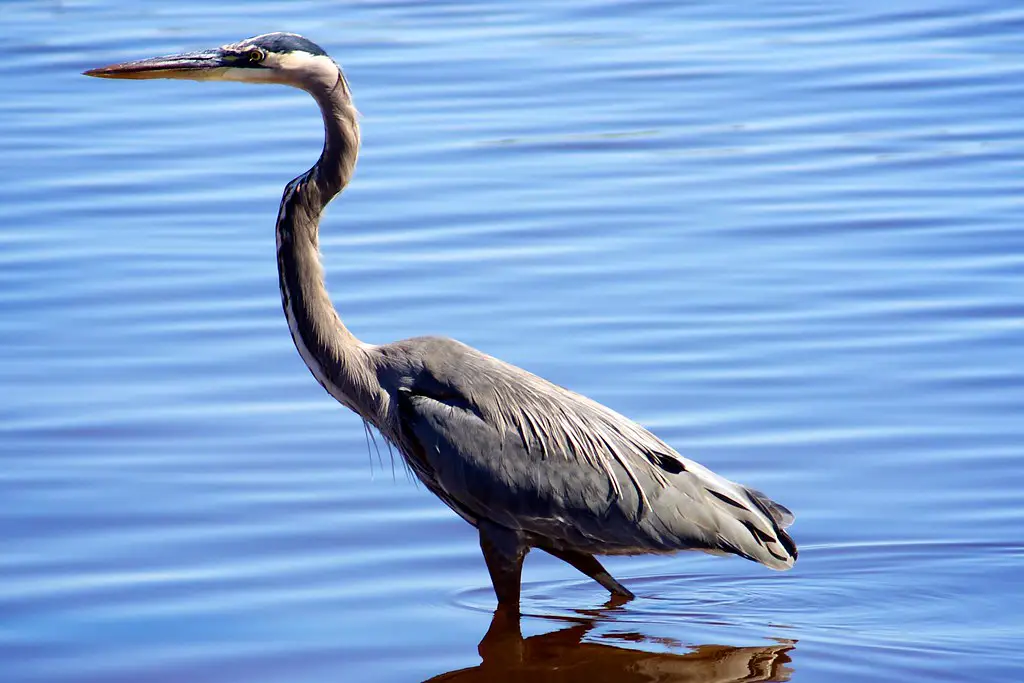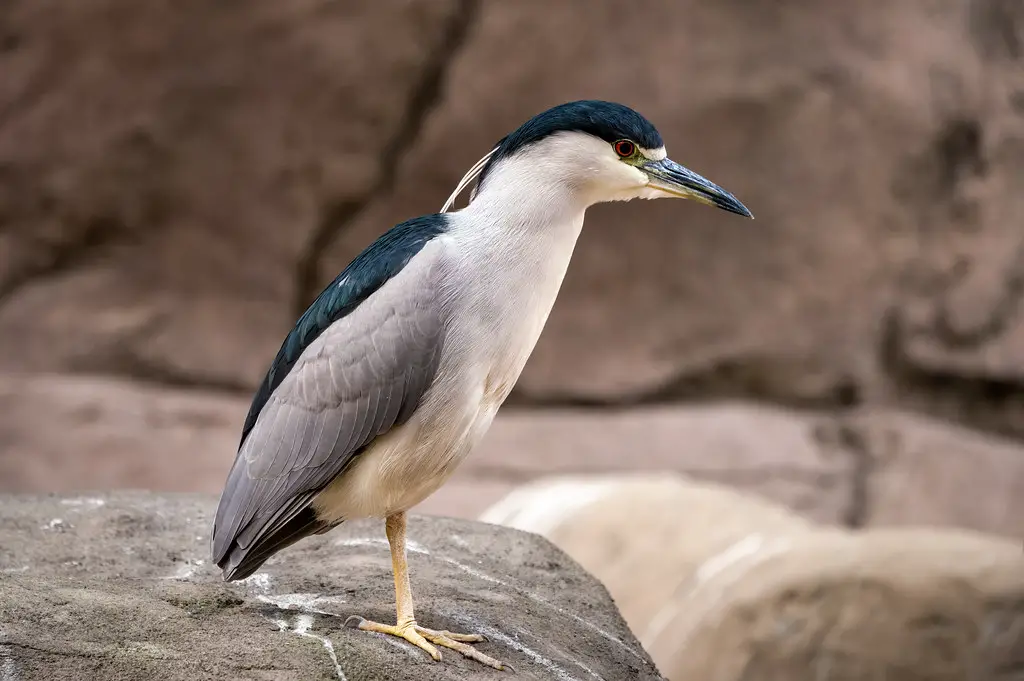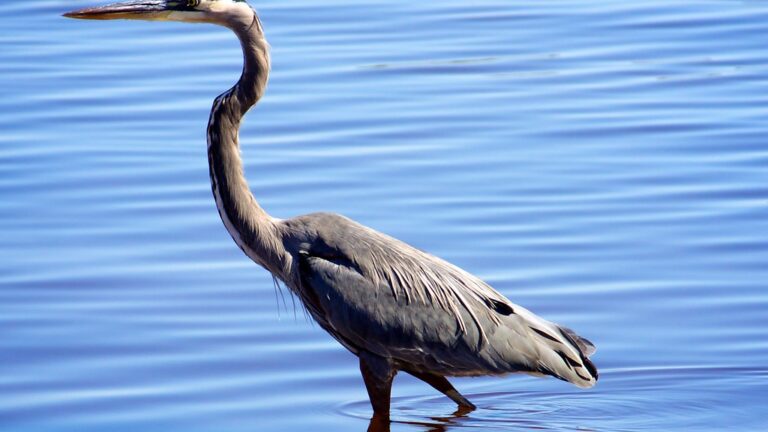Welcome to the world of graceful herons in the beautiful state of Florida! If you’ve ever spotted one of these elegant birds and wondered which species it might be, you’re not alone. Florida is home to a diverse array of heron species, each with its unique features and behaviors.
Identifying herons can be a fascinating yet tricky task due to the variety that thrives in the Sunshine State. In this blog post, we’re here to guide you through the enchanting world of Florida’s herons. We’ll introduce you to the most common heron species that call Florida home, giving you insights into their appearances, habits, and where they can be found. Let’s dive in and explore the remarkable world of herons in Florida together!
List of Herons Found in Florida
Great blue heron

- Scientific name: Ardea alba
- Lifespan: 15 years
- Size: 3 feet
- Native to: Asia, Africa, the Americas, and southern Europe
The Great Blue Heron is one of the most common herons in Florida, and it can be seen year-round. With a wingspan of up to 6 feet, it is one of Florida’s largest birds. The Great Blue Heron is mostly blue-gray, with a white throat and eye stripe, and dark gray wing feathers. It is often found hunting for small fish in the shallows of estuaries, mud flats, and marshes along the seaboard. The heron can be found in various wetland habitats, including saltwater and freshwater marshes, flooded fields, mangrove swamps, and lake shorelines. It stands motionless in shallow water, waiting for fish to come close enough to be caught with its long, yellow bill.
Tricolored heron

- Scientific name: Egretta tricolor
- Lifespan: 17 years
- Size: 24-26 inches
- Native to: Northeastern United States, south along the coast, through the Gulf of Mexico and the Caribbean, to northern South America as far south as Brazil
The Tricolored Heron is a medium-sized wading bird with a blue-gray upper side and chest and a white belly. It is a regular breeding bird in Florida and is most often found in estuaries and saltwater marshes along the Gulf Coast. Tricolored Herons nest in colonies, sometimes forming colonies with other heron species, but they often forage alone and are fiercely protective of their territory. They consume fish, crustaceans, amphibians, and insects and will drive away other wading birds that invade their habitat. Tricolored Herons hunt in shallow waters, usually by patiently waiting until their prey comes within reach.
Little Blue Heron

- Scientific name: Ardea alba
- Lifespan: 15 years
- Size: 3 feet
- Native to: Asia, Africa, the Americas, and southern Europe
The Little Blue Heron is a common breeding bird in Florida and can be seen year-round. Adult Little Blue Herons are slate blue in color, while young birds are entirely white during their first year. Juvenile Little Blue Herons can be distinguished from other white herons by their dark bill and green legs. During winter, their numbers increase due to an influx of birds from further north spending the winter months in Florida. Little Blue Herons feed on small fish, mollusks, and crustaceans, with crayfish forming a large part of their diet. They prefer aquatic habitats and are rarely seen away from water. They build their nests out of sticks and in colonies, and both parents take turns incubating the eggs for up to 25 days.
Great Egret

- Scientific name: Ardea alba
- Lifespan: 15 years
- Size: 3 feet
- Native to: Asia, Africa, the Americas, and southern Europe
The Great Egret is the most common heron species in Florida, and it has a range that spans nearly the entire planet. This large heron is almost entirely white, with long black legs and a yellow beak. During the breeding season, it grows a long white plume on its back that extends to the tip of its tail. The Great Egret can be found in both fresh and saltwater habitats and often nests in large colonies on the shores of marshes, lakes, and rivers. It forages in shallow water, including ponds, lakes, rivers, estuaries, rice fields, and flooded areas, waiting patiently for its prey before striking with its long beak.
Snowy Egret

- Scientific name: Egretta thula
- Lifespan: 16 years
- Size: 20-27 inches
- Native to: United States and southern Canada, south through Central America, the West Indies, South America, and Argentina
The Snowy Egret is another bird with extensive white plumage and has become an increasingly common breeding bird all over Florida. Aggressive conservation efforts were necessary to protect this egret species, which was systematically hunted in previous centuries. The Snowy Egret stands out with its slim black bill and bright area between the eyes and nostrils. Adult birds have black legs that contrast with their yellow feet, which are thought to help attract small fish and other prey. Juvenile birds have greenish-yellow legs with some black areas on the front. The Snowy Egret is found in various wetland environments, from small ponds to saltwater shorelines.
Snowy Egrets feed on fish, crabs, snails, amphibians, and crayfish, which they find in shallow water. They either remain still and wait for prey to approach or stir up the water with their feet to flush out prey to the surface. Their nests can be found in trees or hidden among ground-level bushes, and the female lays 3 to 6 eggs, which are incubated by both parents. During the summer, the Snowy Egret is a rare to relatively common breeding bird in Florida, but it is more common in the state during the winter months, especially in coastal areas.
Cattle egret

- Scientific name: Bubulcus ibis
- Lifespan: 20 years
- Size: 19-21 inches
- Native to: Africa to humid Asian tropics, from India to Japan and northern Australia
The Cattle Egret is smaller than Great Egrets and has shorter necks. It is mostly white with streaks of brownish-orange on the head, throat, and back. The Cattle Egret is a relatively new species in the New World, originating in Europe and Africa. It was first discovered breeding in Brazil and later in Florida, where it appeared in late 1955. Cattle Egrets are common breeding birds all over the southern states and are successful colonizers in the Americas.
Unlike other egrets and herons, Cattle Egrets regularly forage in dry habitats, including high-altitude areas. During the breeding season, adults develop orange plumage on the back of their head, back, and chest. They inhabit a wide range of wetland ecosystems, ranging from shallow saltwater zones to freshwater ponds, swamps, and lakes. In addition to wetlands, Cattle Egrets also forage in dry areas, such as pastures, where they follow cattle and feed on the insects disturbed by the livestock.
Green heron

- Scientific name: Butorides virescens
- Lifespan: 10 years
- Size: 18 inches
- Native to: Northern South America, Mexico, and the United States
The Green Heron is a medium-sized heron with an olive-green body and black wings. It is relatively common in Florida and is often seen around lakes, rivers, ponds, or even swimming pools. The Green Heron feeds on fish, frogs, snails, small reptiles, amphibians, and crustaceans. It nests in trees or shrubs, and if suitable nesting trees are not available, it can also nest on the ground, usually underneath a bush. The Green Heron is usually silent except at dusk or dawn when it makes its characteristic call, which sounds like “kreee.”
Black-crowned Night Heron

Image Source
- Scientific name: Nycticorax nycticorax
- Lifespan: Up to 20 years
- Size: 58-65 centimeters (23-26 inches)
- Weight: 550-800 grams (1.2-1.8 pounds)
- Origin: Worldwide distribution, found near bodies of water
The Black-crowned Night Heron is most active at dusk and during the night when it forages for frogs and small fish in Florida wetlands. It is a common breeding bird and year-round resident in Florida, but it can be hard to spot during the day as it hides in daytime roosts. The mating season brings a change in appearance for this heron, with the black color of the head and back transforming into a glossy greenish-blue. The lores become black, and their feet take on a pink or crimson hue. Black-crowned Night Herons are social birds and usually nest in colonies sharing the same nesting tree.
The Yellow-crowned Night-Heron, scientific name Nyctanassa violacea, is not as nocturnal as its Black-crowned relative and can be seen foraging both during the day and the night. It is most commonly found in coastal areas of Florida, where it forages for food in shallow water. While crustaceans make up the bulk of their diet, they also eat fish, insects, snails, reptiles, amphibians, and rodents. Yellow-crowned Night-Herons are summer visitors in northern parts of the Sunshine State but are encountered year-round in southern Florida.
American bittern

- Scientific name: Botaurus lentiginosus
- Lifespan: 8 years
- Size: 60 cm
- Native to: United States and Canada
The American Bittern is a small heron that lives in marshes and swamps and is extremely well camouflaged to blend in with aquatic vegetation. They have mottled brown patterning and hold their heads pointed upwards while remaining still amid the reeds. Bitterns have a neck that is similar in length to the rest of their body, which they use to catch small fish and other animals in shallow water. They eat a wide variety of aquatic organisms, including fish, crabs, insects, frogs, and small rodents. American Bitterns wait patiently in the reeds for their prey to approach before making a swift, quiet dash forward to catch it in their bills.
The Least Bittern, scientific name Ixobrychus exilis, is hard to spot, as it usually remains hidden in dense reed beds. The best way to identify one of these herons is by its coo-coo-coo call. They have attractive chestnut orange and black color. The best places to see them are marshes and wetlands with dense vegetation, where they can be observed hunting at the edges of open water. Least Bitterns are most active at dawn and dusk when they can also be seen flying to and from their roosting trees. They feed on fish, amphibians, mollusks, insects, and even rodents, foraging by grasping individual reeds with their claws while waiting for small aquatic animals to pass by in the water underneath them.
Reddish egret

- Scientific name: Egretta rufescens
- Length: 80 cm
- Wingspan: 125 cm
- Weight: 600 gm
- Beaks typically measure 7.3–9.2 cm long
The Reddish Egret is a bird of shallow saltwater habitats in coastal areas of the Florida Gulf Coast and the Florida Keys, where they are year-round residents. They have an unusual foraging tactic compared to other herons. Instead of patiently waiting for fish to come within striking distance, Reddish Egrets pursue their prey rapidly on foot and wave their wings to startle prey. They sometimes even take to the air to swoop down on it. Reddish Egrets have a dark morph and a white morph, and the best way to identify them is by their bi-colored bill, which is yellow at the base and black at the tip. The dark morph of the Reddish Egret has a bluish-gray body and a cinnamon-colored head, throat, and breasts.
Final Thoughts on Herons of Florida
As we conclude our exploration of the diverse and enchanting world of herons in Florida, we’ve gained a deeper appreciation for these elegant birds that grace the state’s landscapes. From the magnificent Great Blue Heron to the charming Little Blue Heron and the striking Tricolored Heron, each species brings its unique charm to Florida’s diverse habitats.
Identifying herons may be a challenge, but armed with knowledge, we’re better equipped to appreciate their beauty and understand their role in the ecosystem. Whether you’re enjoying the tranquility of wetlands or the bustling shores of Florida’s waterways, keep an eye out for these captivating creatures.
Further Readings
- Types of Blue Birds in Florida
- Types of Birds of Prey in Florida
- Types of Shore Birds in Florida
- Types of Swallows in Florida
- Birds that Chrip at Night in Florida
- Types of White Birds in Florida
- Types of Owls in Florida
- Types of Red Birds in Florida
- Types of Hummingbirds in Florida
- Types of Hawks in Florida
- Types of Pink Birds in Florida
- Types of Doves in Florida
- Types of Black Birds in Florida


![13 Beautiful Red Birds in Florida [Images + IDs]](https://birdsology.com/wp-content/uploads/2023/03/45-600x400.jpg)
![White Birds In Florida With Long Beaks [With Images]](https://birdsology.com/wp-content/uploads/2022/09/American_White_IbisII-600x400.jpg)
![11 Beautiful hummingbirds in Florida [Pictures + IDs]](https://birdsology.com/wp-content/uploads/2023/03/14534381519_fdb8dd9304_b-600x400.jpg)
![21 Brown Birds in Florida [Images + IDs]](https://birdsology.com/wp-content/uploads/2023/08/49945210533_2645c29620_b-600x400.jpg)